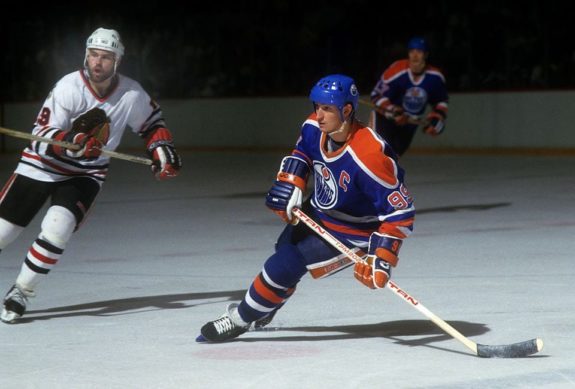On Sunday, April 26, LeafsNation hockey reporter Zach Laing wrote an interesting post looking back over the history of professional hockey in Toronto. Although the post wasn’t about the Toronto Maple Leafs per se, he suggested that there was a chance that Sidney Crosby, who turned out to be a truly generational player with the NHL’s Pittsburgh Penguins, could have played in Toronto.

He wouldn’t have played with the Maple Leafs, but he might have played in Toronto nonetheless.
Related: Remembering Borje Salming: “King” of Maple Leafs’ Defensemen
Laing’s post is an interesting piece and I encourage Maple Leafs fans who are interested in hockey history to take a look at it.
The 2004-05 Season and the Backstory to the NHL’s Salary-Cap Era
During the offseason between the 2018-19 and the 2019-20 season, Maple Leafs news was filled with the daily speculations of the protracted contract negotiations between Maple Leafs general manager Kyle Dubas and the team’s young star Mitch Marner. Eventually, Marner signed for six-years, $65 million with the Maple Leafs on Sept. 13, 2019, and was able to attend the team’s training camp. Marner, as is his right, wanted the largest salary he could negotiate; while, on the other side, Dubas had to keep his team’s total salary structure under the salary-cap limit of $81.5 million.

Contract battles have not always been the way they currently are in the NHL, with the incursion of the salary-cap era. These seemingly annual negotiations general managers engage in – trying to negotiate contracts that keep their respective teams under the annually changing upper limits of that salary cap – are relatively new. Young NHL fans might not recall that the 2004-05 NHL season was marred with a labor lockout that canceled most of the season.
The main issue in 2004-05 was the NHL’s desire to implement a salary cap as a way to limit what each team spent on players’ salaries and create an equitable balance throughout the league. Obviously, the NHL Players Association (NHLPA) opposed that plan and hoped to negotiate an alternative way to share revenue between the players and the teams. However, attempts to reach an agreement through collective bargaining were unsuccessful. Neither side would budge on its demands.
Related: Pittsburgh Penguins’ All-Time Greatest Lines
As a result, on Sept. 16, 2004, a day after the existing collective bargaining agreement (CBA) expired, the rinks were closed and players were locked out. Attempts to negotiate a new CBA were unsuccessful and, in desperation, the entire NHL season was canceled in Feb. 2005. It was the first time since 1919 that Lord Stanley’s Cup was not awarded to any NHL team.
The NHL management and the NHLPA finally reached a negotiated agreement on July 13, 2005, ending the lockout. That agreement resulted in the institution of both a salary cap and the concept of revenue sharing between NHL players and management. The lockout lasted just over 10 months and more than 1,200 games had been canceled – making the COVID-19 pandemic’s current impact on the NHL’s regular season seem small in comparison.
Moving Ahead to the Sidney Crosby and Toronto Connection
During that lockout, a large number of NHL players traveled to play in established European leagues. However, the lockout also spurred other creative possibilities. One possibility was the idea to revive a long-dead upstart hockey league – the World Hockey Association (WHA). The WHA had ceased operations prior to the 1979-80 season; however, when it was dissolved four teams joined the NHL – the Edmonton Oilers, New England Whalers, Quebec Nordiques, and the Winnipeg Jets.

According to Laing’s post in 2003, two men – Allan Howell and Dr. Nick Vaccaro – hatched the idea of reviving the WHA. They talked Bobby Hull into becoming the commissioner of the new league and saw the impending NHL lockout as the opportunity they needed to begin their new league during the 2004-05 season.
Related: Maple Leafs: Whipping Boys From the Last Decade
The two men planned to capitalize on the protracted lockout everyone knew was coming. Laing cited an old Pierre LeBrun article written in 2003 that noted,
“Right now, the number of (NHL) players that are under contract past 2004 you can probably count on your hands and feet,” Howell told The Canadian Press. “If, in fact, we’re correct about the two-year (NHL) lockout, there’s going to be two years worth of kids coming out of junior with no place to play. And we think that anyone that’s 30 years or older will also be looking for opportunities and other places to play.”
The league was able to gather interest from a number of cities (Dallas, Detroit, Halifax, Hamilton, Miami, Toronto, Vancouver, and Quebec City) to become a part of the action. The Toronto franchise would be known as the Toros – the original WHA name. In 2004, the league held two drafts – an amateur draft and a free-agent draft.

The first amateur selection went to Toronto, who picked the best major junior hockey player around at the time – Sidney Crosby. Crosby was offered a three-year, $7.5-million contract; however, it wasn’t from Toronto but was from the owner of the Hamilton franchise. The contract included a $2 million signing bonus even if the league never got off the ground. Perhaps wisely, Crosby turned down the offer and went on to play another season with Rimouski Oceanic.
As reported by CBC sports at the time, Crosby’s father Troy told the Globe and Mail.
“It wasn’t an easy decision and the offer was flattering. It was a lot of money. I realize some people might not understand why Sidney turned down the offer. But he has his mind made up right now about where he wants to play. He wants to stick with his plan of playing another year in Rimouski.”
What Happened to Crosby?
My heading above is quite tongue-in-cheek. All NHL fans know how the story ends. As history will show, Crosby had an incredible season in Rimouski and by doing so cemented his status as everyone’s first pick in the 2005 NHL Entry Draft.
Related: One for the Ages: Guy Lafleur’s 1989-90 NHL Season
Crosby continues to star with the Penguins for whom he’s scored over 100 points in six seasons. As Laing points out in his article, Crosby will be a certain Hockey Hall of Famer one day.
Still, he might have played in Toronto. How interesting that might have been.